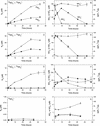Factors controlling anaerobic ammonium oxidation with nitrite in marine sediments
- PMID: 12147475
- PMCID: PMC124030
- DOI: 10.1128/AEM.68.8.3802-3808.2002
Factors controlling anaerobic ammonium oxidation with nitrite in marine sediments
Abstract
Factors controlling the anaerobic oxidation of ammonium with nitrate and nitrite were explored in a marine sediment from the Skagerrak in the Baltic-North Sea transition. In anoxic incubations with the addition of nitrite, approximately 65% of the nitrogen gas formation was due to anaerobic ammonium oxidation with nitrite, with the remainder being produced by denitrification. Anaerobic ammonium oxidation with nitrite exhibited a biological temperature response, with a rate optimum at 15 degrees C and a maximum temperature of 37 degrees C. The biological nature of the process and a 1:1 stoichiometry for the reaction between nitrite and ammonium indicated that the transformations might be attributed to the anammox process. Attempts to find other anaerobic ammonium-oxidizing processes in this sediment failed. The apparent K(m) of nitrite consumption was less than 3 microM, and the relative importance of ammonium oxidation with nitrite and denitrification for the production of nitrogen gas was independent of nitrite concentration. Thus, the quantitative importance of ammonium oxidation with nitrite in the jar incubations at elevated nitrite concentrations probably represents the in situ situation. With the addition of nitrate, the production of nitrite from nitrate was four times faster than its consumption and therefore did not limit the rate of ammonium oxidation. Accordingly, the rate of this process was the same whether nitrate or nitrite was added as electron acceptor. The addition of organic matter did not stimulate denitrification, possibly because it was outcompeted by manganese reduction or because transport limitation was removed due to homogenization of the sediment.
Figures



References
-
- Braman, R. S., and S. A. Hendrix. 1989. Nanogram nitrite and nitrate determination in environmental and biological materials by vanadium (III) reduction with chemiluminescence detection. Anal. Chem. 61:2715-2718. - PubMed
-
- Canfield, D. E., B. B. Jørgensen, H. Fossing, R. N. Glud, J. K. Gundersen, N. B. Ramsing, B. Thamdrup, J. W. Hansen, L. P. Nielsen, and P. O. J. Hall. 1993. Pathways of organic carbon oxidation in three continental margin sediments. Mar. Geol. 113:27-40. - PubMed
-
- Canfield, D. E., B. Thamdrup, and J. W. Hansen. 1993. The anaerobic degradation of organic matter in Danish coastal sediments: iron reduction, manganese reduction, and sulfate reduction. Geochim. Cosmochim. Acta 57:3867-3883. - PubMed
-
- Cole, J. A. 1987. Assimilatory and dissimilatory reduction of nitrate to ammonia, p. 281-329. In J. A. Cole and J. Ferguson (ed.), The nitrogen and sulphur cycles. Society for General Microbiology Symposium 42. Cambridge University Press, Cambridge, England.
Publication types
MeSH terms
Substances
LinkOut - more resources
Full Text Sources
Other Literature Sources

